远程操作矿用双速运输绞车的设计(含CAD图纸源文件)
收藏
资源目录

压缩包内文档预览:(预览前20页/共82页)
编号:10454171
类型:共享资源
大小:9.56MB
格式:ZIP
上传时间:2018-08-15
上传人:机****料
认证信息
个人认证
高**(实名认证)
河南
IP属地:河南
50
积分
- 关 键 词:
-
远程
操作
矿用双速
运输
绞车
设计
cad
图纸
源文件
- 资源描述:
-

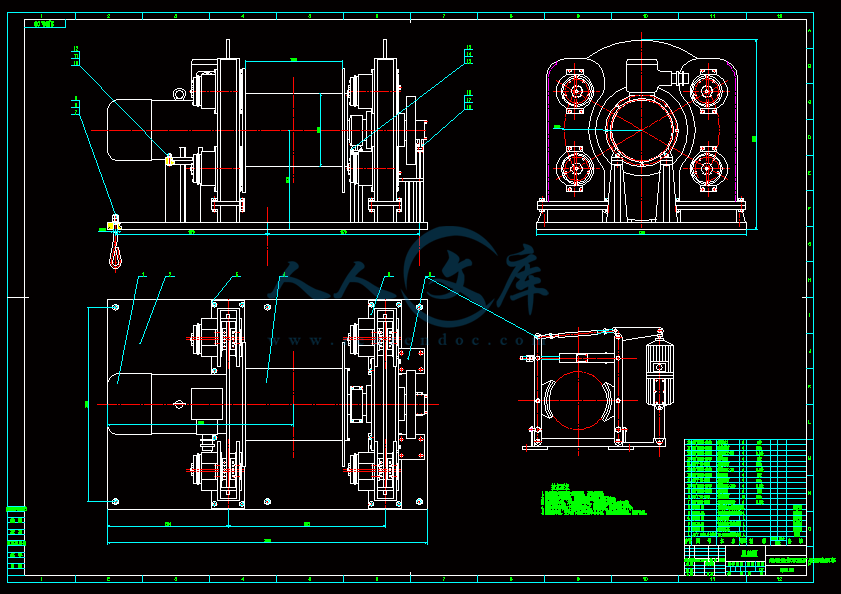
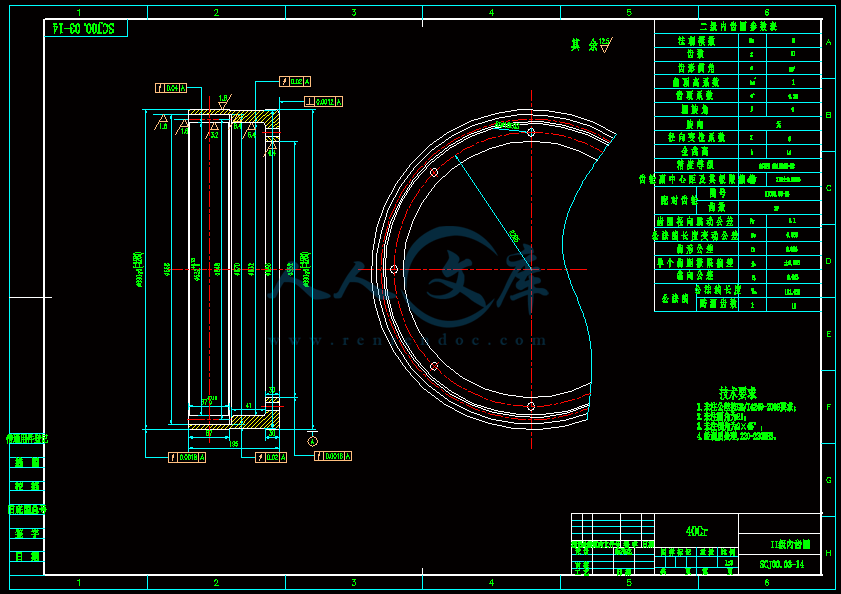



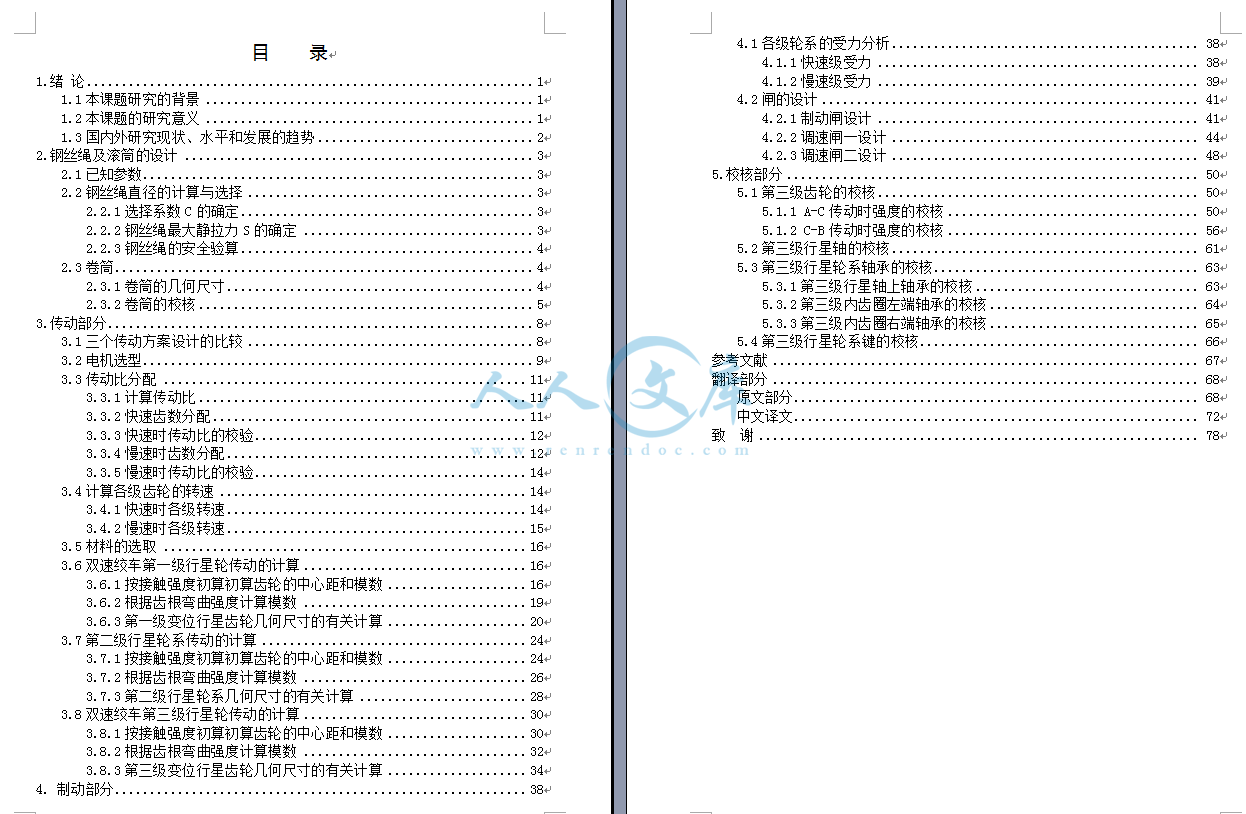

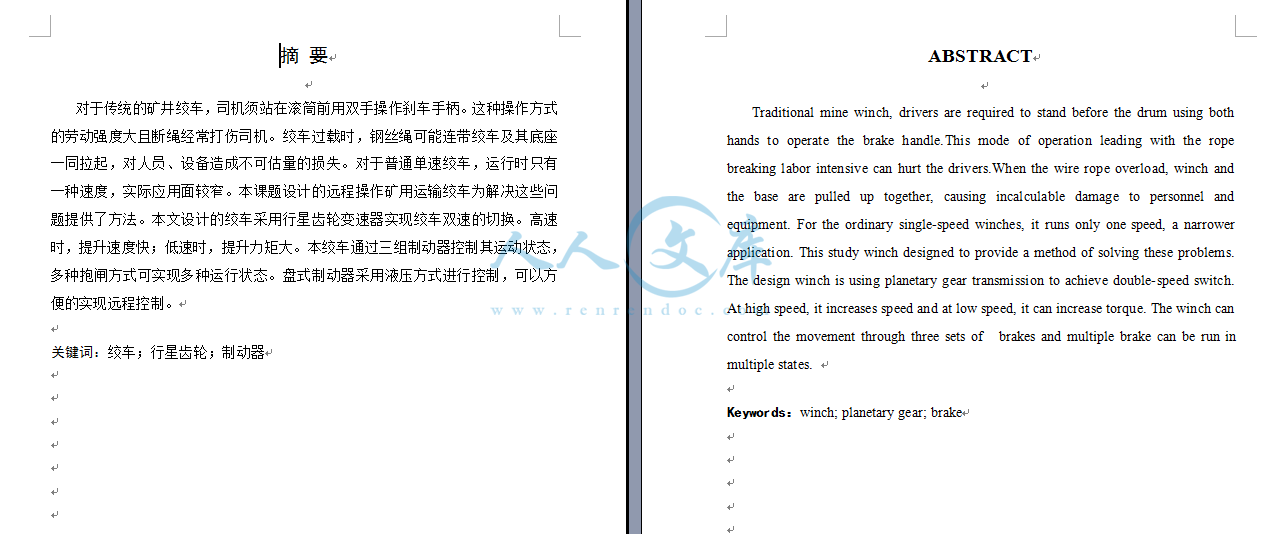
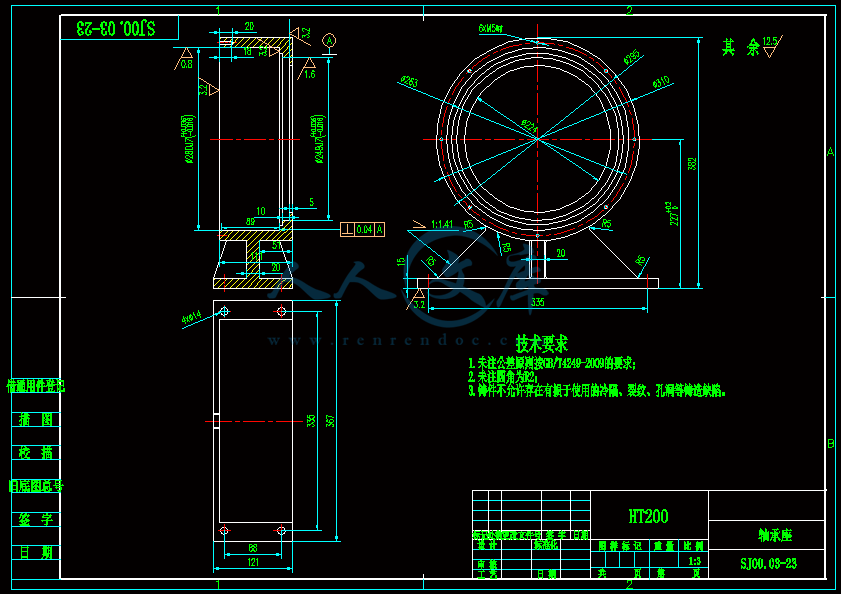
- 内容简介:
-
论文题目: 远程操作矿用双速运输绞车的设计,学生,设计参数:1.快速时:钢丝绳静张力40KN,基层钢丝绳速度1.6m/s2.慢速时:钢丝绳静张力60KN,基层钢丝绳速度0.4m/s,课题研究的背景和意义,矿用运输绞车是司机须站在滚筒前用双手操作刹车手柄,这种操作方式不仅劳动强度大,而且非常不安全,断绳经常打伤司机,过载时钢丝绳连带绞车及其底座一同拉起。 本课题设计的绞车通过液压制动器和多级行星齿轮传动实现变速切换,一方面解放劳力,一方面提高安全强度,双速可以适用于不同的工况,绞车的使用效率提高,1.传动部分,第一种传动方案,1.传动部分,第二种传动方案,1.传动部分,第三种传动方案,1.传动部分,第一种传动方案:占地空间相对较大,第二级行星架安装难度较大,结构较复杂。 第二种传动方案:体积小,结构紧凑,但快速级仅仅有一级传动,速比系数太大,方案太复杂。 第三种传动方案:体积小,传动效率高,结构也紧凑。 综上所述,选用第三种传动方案,2.制动部分,松闸过程: 油缸供油,活塞杆在压力油缸的推动下左移,带动左闸瓦离开制动盘,由于制动钳体是浮动的右闸瓦在制动盘的轻触下带动前提左移,离开制动盘,完成松闸,制动过程: 停止向液压缸供油,油缸中的液压油在碟簧的推动下排出,碟簧推动左闸瓦右移,贴向制动盘,以制动盘为支点,在碟簧的推动下,使缸体带动浮钳体左移,使右闸瓦贴向制动盘,2.制动部分,3.液压传动原理 本 科 生 毕 业 论 文姓 名: 学 号: 学 院: 专 业: 机械工程及自动化 论文题目: 远程操作矿用双速运输绞车的设计 专 题: 指导教师: 职 称: 教授 任务书专业年级 学号 学生姓名 任 务 下 达 日 期 : 毕业论文日期: 毕业论文题目:远程操作矿用双速运输绞车的设计毕业论文专题题目:毕业论文主要内容和要求:矿用运输绞车是司机须站在滚筒前用双手操作刹车手柄,这种操作方式不仅劳动强度大,而且非常不安全,断绳经常打伤司机,过载时钢丝绳连带绞车及其底座一同拉起。本课题设计的绞车通过液压离合器和多级行星齿轮传动实现变速切换,高速时提升速度快;低速时,提升力矩大,液压制动器制动滚筒。通过控制电机、液压制动器,远离滚筒实现远程操作。本课题涉及机械、液压、控制系统的设计,可较好锻炼学生机械、液压、监控的综合设计能力,培养学生具有开发和设计机电产品的能力。本课题包括电动机选型、多级行星齿轮传动方式比较与选择、多级行星齿轮传动的设计、绞车卷筒的设计、液压制动器设计等。进行各部分的结构设计、受力分析、强度计算、参数选择、标准零部件的选用,运用标准、规范、手册、图册与图表绘制装配图和零件图。指导教师签字:郑 重 声 明本人所呈交的毕业论文,是在导师的指导下,独立进行研究所取得的成果。所有数据、图片资料真实可靠。尽我所知,除文中已经注明引用的内容外,本毕业论文的研究成果不包含他人享有著作权的内容。对本论文所涉及的研究工作做出贡献的其他个人和集体,均已在文中以明确的方式标明。本论文属于原创。本毕业论文的知识产权归属于培养单位。本人签名: 日期: 毕业论文指导教师评阅书指导教师评语(基础理论及基本技能的掌握;独立解决实际问题的能力;研究内容的理论依据和技术方法;取得的主要成果及创新点;工作态度及工作量;总体评价及建议成绩;存在问题;是否同意答辩等):成 绩: 指导教师签字:年 月 日毕业论文评阅教师评阅书评阅教师评语(选题的意义;基础理论及基本技能的掌握;综合运用所学知识解决实际问题的能力;工作量的大小;取得的主要成果及创新点;写作的规范程度;总体评价及建议成绩;存在问题;是否同意答辩等):成 绩: 评阅教师签字:年 月 日毕业论文答辩及综合成绩答 辩 情 况回 答 问 题提 出 问 题 正 确基 本正 确有 一般 性错 误有 原则 性错 误没 有回 答答辩委员会评语及建议成绩:答辩委员会主任签字: 年 月 日学院领导小组综合评定成绩:学院领导小组负责人: 年 月 日 翻译部分原文部分Electrical Winch Controlsby Tom YoungThe form of motor control we all know best is the simple manual station with up and down pushbuttons. While these stations may still be the perfect choice for certain applications, a dizzying array of more sophisticated controls is also available. This article addresses the basic electrical requirements of the motors and user interface issues you will need to address before spcifying, building or buying winch controls.begin with, the manual control stations should be of the hold-to-run type, so that if you take your finger off of the button the winch stops. Additionally, every control station needs an emergency stop (E-stop) that kills all power to the winch, not just the control circuit. Think about itif the winch isnt stopping when it should, you really need a failsafe way to kill the line power. Its also a great idea to have a key operated switch on control stations, especially where access to the stations is not controlled.Safe operation by authorized personnel must be considered when designing even the simplest manual controls.Controlling Fixed Speed MotorsThe actual controlling device for a fixed speed winch is a three phase reversing starter. The motor is reversed by simply switching the phase sequence from ABC to CBA. This is accomplished by two three-pole contactors, interlocked, so they cant both be closed at the same time. The NEC requires both overload and short circuit protection. To protect the motor from overheating due to mechanical overloads a thermal overload relay is built into the starter. This has bi-metallic strips that match the heating pattern of the motor and trips contacts when they overheat. Alternatively, a thermistor can be mounted in the motor winding to monitor the motor temperature. Short circuit protection is generally provided by fuses rated for use with motors.A separate line contactor should be provided ahead of the reversing contactor for redundancy. This contactor is controlled by the safety circuits: E-stop and overtravel limits. This brings us to limit switches. When you get to the normal end of travel limit the winch stops and you can only move it in the opposite direction (away from the limit). There also needs to be an overtravel limit in case, due to an electrical or mechanical problem, the winch runs past the normal limit. If you hit an overtravel limit the line contactor opens so there is no way to drive off ofthe limits. If this occurs, a competent technician needs to fix the problem that resulted in hitting the overtravel limit. Then, you can override the overtravels using the spring return toggle switch inside the starteras opposed to using jumpers or hand shooting the contactors.Variable Speed RequirementsOf course, the simple fixed speed starter gets replaced with a variable speed drive. Heres where things start to get interesting! At the very least you need to add a speed pot to the control station. A joystick is a better operator interface, as it gives you a more intuitive control of the moving piece.Unfortunately, you cant just order any old variable speed drive from your local supplier and expect it to raise and lower equipment safely and reliably over kids on stage. Most variable speed drives wont, as they arent designed for lifting. The drive needs to be set up so that torque is developed at the motor before the brake is released, and (when stopping) the brake is set before torque is taken away.For many years DC motors and drives provided a popular solution as they allowed for good torque at all speeds. The large DC motors required for most winches are expensive, costing many times what a comparable AC motor costs. However, the early AC drives were not very useful, as they had a very limited speed range and produced low torque at low speeds. More recently, as the AC drives improved, the low cost and plentiful availability of AC motors resulted in a transition to AC drives.There are two families of variable speed AC drives. Variable frequency inverters are well known and readily available. These drives convert AC to DC, then convert itback to AC with a different frequency. If the drive produces 30 Hz, a normal 60 Hz motor will run at half speed. In theory this is great, but in reality there are a couple of problems. First, a typical 60 Hz motor gets confused at a line frequency below 2 or 3 Hz, and starts to cog (jerk and sputter), or just stops. This limits you to a speed range of as low as 20:1hardly suitable for subtle effects on stage! Second, many lower cost inverters are also incapable of providing full torque at low speeds. Employing such drives can result in jerky moves, or a complete failure to lift the pieceexactly what you dont want to see when you are trying to start smoothly lifting a scenic element. Some of the newer inverters are closed loop (obtain feedback from the motor to provide more accurate speed control) and will work quite well.The other family of AC drives is flux vector drives. These units require an encoder mounted on the motor shaft allowing the drive to precisely monitor the rotation of the armature. A processor determines the exact vector of magnetic flux (thus flux vector drive) required to rotate the armature the next few degrees at a given speed. These drives allow an infinite speed range, as you can actually produce full torque at zero speed. The precise speed and position control offered by these drives make them a favorite in high performance applications.PLC-based controls provide system status as well as control options. This screen give the operator full access to Carnegie Halls nine stage floor lifts.PLC Based SystemsA PLC is a programmable logic controller. First developed to replace the relay based industrial control systems of the 50s and 60s, these controls are at home in rugged, industrial environments. These are modular systems with a great variety of I/O modules allowing semi-custom hardware configurations to be assembled easily at a reasonable price. These include position control modules, counters, A/D and D/A converters and all sorts of solid state or hard contact closure outputs. The great variety of I/O components and the modular nature of the PLC make this an effective way to build custom and semi-custom control systems.The greatest drawback to PLC systems is the lack of really great displays to tell you what they are doing or to help you program them. Monochrome and medium resolution color displays are the norm, as the primary use for these components in on a factory floor.One of the first major PLC systems used in a large entertainment venue is the complex lift and wagon system at the original MGM Grand (now Ballys) in Las Vegas. Several manufacturers offer standard PLC-based systems and a host of semi-custom acoustic banner, shell, and lift control systems is also available. The ability to build custom systems from standard building blocks is the greatest strength of PLC-based controls.High End ControllersThe most sophisticated rigging controllers go well beyond speed, time, and position control. They include the ability to write complex cues, record profiled moves, and manage multiple cues running at once.Many of the larger opera houses are moving toward point hoist systems, where there is a separate winch for each lift line (the rigging equivalent of dimmer per cir cuit). When multiple winches are used to carry a single piece, the winches must be perfectly synchronized, or the load can shift so that an individual winch can become dangerously overloaded. The control system must be able to keep selected winches in synch or provide a rapid, coordinated stop if a winch is unable to stay in synch with the others. With a typical top speed of of each other240 fpm and a requirement to keep the winches within a 1/8, you have less than three milliseconds to recognize a problem, attempt to correct the errant winchs speed, determine that youve failed and initiate a coordinated stop of all the winches in the group. This takes a lot of computing, fast I/O, and well-written software.There are two very different approaches to large rigging control systems. Originally, a single console was used, with the usual problem of where it should be located for the operators optimum view. Unfortunately this can change not only from show to show, but also from one cue to the next. This dilemma has been partially addressed by using video cameras at different locations in conjunction with 3D screen graphics that allow the operator to view the expected rigging motion three dimensionally from any viewpoint. This allows the operator to view the on screen movement of the rigging from a viewpoint that matches his actual view of the stage, or the actual view of a closed circuit camera. For complex moves with inter-related pieces this makes the control and understanding of what is happening much simpler.The other approach is a distributed system, with several portable consoles. This allows different operators to control different aspects of the rigging, in the same manner we have done with manual sets. A dramatic example of this approach is used by the Royal Opera at Covent Garden, where there are ten consoles controlling a total of 240 motors. Each console has five playbacks, and is set up so that each motor is assigned to a single console. One operator and console could control everything, but frequently one console may be running stage lifts, another the onstage rigging, and a third is being used backstage to move stored drops.Cutting-edge portable consoles allow multiple operators to control the action from the best vantage points and provide 3D displays.Reprinted from PROTOCOL, the Journal of the Entertainment Services and Technology Association () Fall 2003 issue. 2003 ESTA.ConclusionThe tremendous variety of rigging control systems currently available ranges from the pushbutton station to complex multi-user computerized control system. When shopping for rigging control systems you generally get what you pay for. The most important features are safety and reliability. These are features with real value, and you should expect to pay a fair price for this security. Work with an established manufacturer who can show you working installations and who will put you in contact with users who have requirements similar to yours. 中文译文电力绞车的控制对于电动机的控制,我们所知道的最好的方式就是使用由许多点动式按钮组成的简单的手工操作台。而这种操作台在某些应用方面可能仍然是个不错的选择,如一些令人头痛的复杂的控制也可以用。这篇文章讲述了,在你设计、组建或是购买绞车控制器之前,你必须对电动机的基本电气设备和你将需要寻址的用户接口命令进行编址。首先,手动控制台应该是手动控制型的,因此,如果你把你的手指移开按钮,绞车就会停车。另外,每个控制工作站都需要配备紧急制动闸,紧急制动闸可以切断绞车的所有电源,而不仅仅是控制电路的。仔细想想看,如果绞车在该停车时,它却没有停下来,你就确实需要一种故障保障的方法去切断线路的电源。在控制工作台上设置一个关键操作开关,也是一个非常好的主意,特别是在通向工作站的线路不能控制时,就可以用那个开关来控制。(在设计控制台时,即使是最简单的手工控制台,也要考虑设置由专门人员操作的安全操作按键。)控制定速电动机对于一台定速绞车的实际控制设备是一台三相起动器。电动机的转向被反向,是通过简单的开关控制相序从 A-B-C 变换到 C-B-A。这些动作被完成,是通过两个三磁极式电流接触器,而且它们是互锁的,所以,它们不可能被同时关闭。NEC 公司要求同时拥有过载和短路保护装置。为了保护电动机免受由于机械过载引起的过热的影响,在起动器内要安装热量过载延迟装置。当热量过载延迟装置过热时,它所拥有的双金属长条断开电动机的电源。除此外,还可以选择一台电热调节器可以用缠绕的方式安装在电动机上,它可以用于监控电动机的温度变化。对于短路保护,我们一般是通过电动机常用的熔断器来实现的。一台独立的线性电流接触器,被配置的电流接触器应该超过主回路的电流接触器,从而达到冗余的目的。这台电流接触器是由安全电路来控制的,如:紧急制动和越程极限。我们可以使用限位开关来实现上述的操作。当你到达正常的行程极限位置末端时,绞车就会停车,并且你只能够向相反的方向移动绞车(即远离极限位置的方向)。这里也需要一个越程限制以防万一,由于电气的或者机械的问题,而使绞车的运行超过正常的极限位。如果你碰到越程限制器,线形电流接触器就会打开,因此,绞车将无法被驱动超过这个极限位置。如果上述情况发生,就需要请专业的技术人员来检查导致碰到越程限制器的具体原因。然后,你就能够用起动器内部的弹力恢复拨动开关来处理越程的问题,而不是使用跳闸器或是手工切断电流接触器。变速的必要条件当然,简单的定速起动器被变速驱动器所取代。这就使事情开始变得有趣起来了!至少,你需要在控制操作台上增加一个速度表盘。操纵杆是一个较好的操作接口,由于它使你对部件的移动有一个更直观的控制。不幸的是,你不能仅仅从你的本地控制台去发命令控制老式的变速驱动器,此外,你不能希望它在初始阶段,就能安全而可靠的提升与下放设备。大多数的变速驱动器不能实现上述的要求,因为它们并不是设计用来做提升工作的。驱动器需要设置成在制动器松开之前,就能够在电动机上产生扭矩,并且,当停车时,即在扭矩撤销之前,制动器将先动作。许多年来,直流电动机和驱动器提供了一些普遍的解决方案,如它们在各种速度时都具有良好的力矩特性。对于大多数的绞车所需求的大型直流电动机是很贵的,那要比同类型的交流电动机贵得多。虽然,早期的交流驱动器不是非常有用,如它们有一个非常有限速度适用范围,而且仅产生低速小扭矩。如今,随着直流驱动器的发展,低成本而且大量可用的交流电动机的出现,导致了一场交流驱动的革命。变速交流驱动器有两个系列。变频转换器已经家喻户晓,而且的确很容易使用。这些驱动器将交流转换成直流,然后,再把它转换回交流,转换后的交流已经是不同频率的。如果驱动器产生 30Hz 的交流,一台正常的 60Hz 的电动机将以一半的速度运行。从理论上说,这非常好,但是,在实际中,这将会有很多的问题。首先,一台典型的 60Hz 的电动机在线性频率低于 2Hz 或是 3Hz 的区域会出现误差,并且,开始嵌齿(即急推,猛拉),或是停车。这将限制你的速度范围低于 20:1,几乎不适应于运行阶段的细微调节。其次,许多低成本的转换器也不能够在低速时提供额定扭矩。使用这些驱动器,将导致急速移动,或是对于提升部件完全的失效,准确地说,当你试图去平稳的提升一台科学仪器时,你不愿看到这样的情况。一些新型的变极器是闭环系统(从电动机获得反馈,提供更加准确的速度控制),并且使电动机将会工作的相当好。交流驱动器的另一个系列是流量矢量型驱动器。这些元器件要求在电动机的主轴上安装编码器,使用这些编码器会使驱动器可以准确地监控电机电枢的旋转。处理器测定了准确的磁性流量的矢量值,这些值要求使电枢在给定的速度下旋转。这些驱动器允许有无穷大的速度,因此,你实际能够在零速度时就产生额定扭矩。这些驱动器所提供的准确的速度和位置的控制,使这些驱动器在高性能应用方面受到欢迎。(基于 PLC 的控制器提供有系统状态和控制选项。这个屏幕展示给操作者全面的访问卡内基霍尔德的九层电梯提升的控制面板。)基于 PLC 的系统一台 PLC 的全称是可编程序逻辑控制器。首先,PLC 的控制器发展到取代了基于五六十年代的工业控制系统的继电器,它们工作在室内的恶劣的工业环境中。这些是模块化
- 温馨提示:
1: 本站所有资源如无特殊说明,都需要本地电脑安装OFFICE2007和PDF阅读器。图纸软件为CAD,CAXA,PROE,UG,SolidWorks等.压缩文件请下载最新的WinRAR软件解压。
2: 本站的文档不包含任何第三方提供的附件图纸等,如果需要附件,请联系上传者。文件的所有权益归上传用户所有。
3.本站RAR压缩包中若带图纸,网页内容里面会有图纸预览,若没有图纸预览就没有图纸。
4. 未经权益所有人同意不得将文件中的内容挪作商业或盈利用途。
5. 人人文库网仅提供信息存储空间,仅对用户上传内容的表现方式做保护处理,对用户上传分享的文档内容本身不做任何修改或编辑,并不能对任何下载内容负责。
6. 下载文件中如有侵权或不适当内容,请与我们联系,我们立即纠正。
7. 本站不保证下载资源的准确性、安全性和完整性, 同时也不承担用户因使用这些下载资源对自己和他人造成任何形式的伤害或损失。

人人文库网所有资源均是用户自行上传分享,仅供网友学习交流,未经上传用户书面授权,请勿作他用。
 川公网安备: 51019002004831号
川公网安备: 51019002004831号